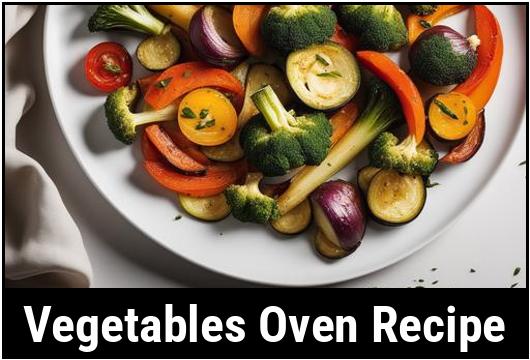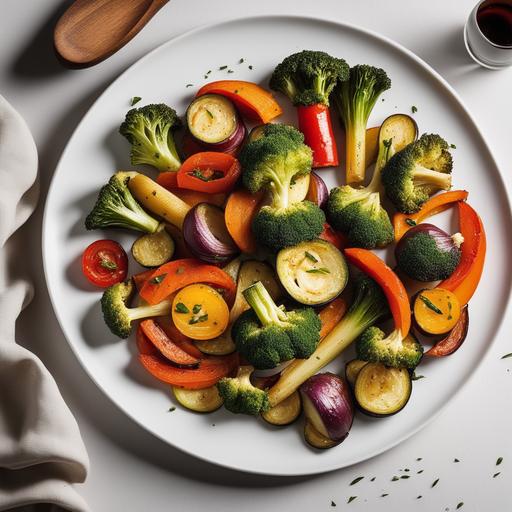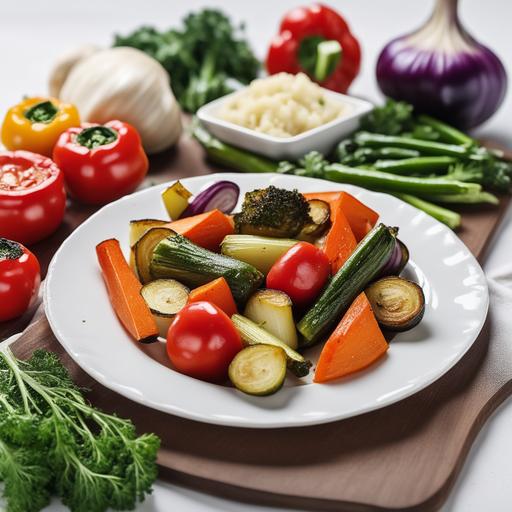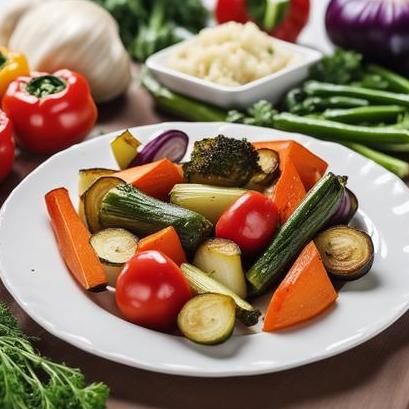
The Ultimate Guide To Oven-Baked Vegetable Recipes
When it comes to healthy and delicious meals, oven-baked vegetables are a fantastic choice. Not only are they packed with essential nutrients, but they also offer a variety of flavors and textures that can elevate any dish. In this comprehensive guide, we will delve deep into the world of oven-baked vegetable recipes. From the science behind their cooking process to culinary tips, we’ve got you covered.
Food Science of Oven-Baked Vegetables
Oven-baking vegetables brings out their natural flavors and caramelizes their sugars, resulting in a delightful combination of tastes and textures. Understanding the food science behind this process will help you make the most of your culinary endeavors.
Maillard Reaction and Caramelization
One key aspect of oven-baking vegetables is the Maillard reaction. This chemical reaction occurs when amino acids and reducing sugars combine under high heat. As a result, the vegetables develop a rich, browned exterior and a complex flavor profile.
Caramelization is another process that enhances the taste of oven-baked vegetables. It occurs when the natural sugars in the vegetables break down and transform into a deeper, sweeter flavor during cooking.
Retention of Nutrients
Oven-baking vegetables generally helps to retain more nutrients compared to boiling or frying. While some vitamins, such as Vitamin C, are susceptible to heat degradation, other beneficial compounds like dietary fiber and certain antioxidants remain intact throughout the cooking process.
Selecting the Right Vegetables
Selecting fresh and high-quality vegetables is crucial for a successful oven-baked vegetable dish. Here are some tips for choosing the perfect produce:
Opt for Seasonal Vegetables
Seasonal vegetables are not only abundant, but they also tend to have superior flavor. Head to your local farmer’s market or grocery store and choose vegetables that are in their prime season.
Diversity and Color
Create a visually appealing and nutritious dish by selecting vegetables of different colors. Vibrant vegetables like bell peppers, carrots, or beets not only add a pop of color to your plate but also contain various beneficial nutrients.
Firmness and Freshness
When choosing vegetables, make sure they are firm to the touch and free from bruises or blemishes. Fresh vegetables will have a crisp texture and a vibrant appearance.
Cleaning and Preparation

Properly cleaning and preparing vegetables is essential to remove dirt, pesticides, and any potential contaminants. Follow these steps for optimal safety and flavor:
Washing
Begin by rinsing your vegetables thoroughly under running water. Gently rub the surfaces to remove any dirt or debris. Some vegetables with rough skins, such as potatoes or carrots, may benefit from a light scrub with a vegetable brush.
Soaking
For vegetables that have been exposed to pesticides or require a deeper clean, consider soaking them in a mixture of water and vinegar or salt for a few minutes. Rinse them thoroughly afterward to eliminate any residual solution.
Drying and Cutting
Pat dry your vegetables after washing them to remove excess moisture that might hinder the caramelization process. Once dry, proceed with cutting the vegetables into desired shapes and sizes. Uniformity in size ensures even cooking.
Tips for Oven-Baked Vegetable Success

The Right Cooking Temperature
Set your oven to a temperature between 375°F (190°C) and 425°F (220°C) to achieve the perfect balance between caramelization and tenderness. Different vegetables might require slight adjustments in temperature.
The Magic of Seasonings
Elevate the flavors of your oven-baked vegetables by adding herbs, spices, or marinades. Whole garlic cloves, rosemary sprigs, or a sprinkle of cayenne pepper can transform a simple dish into something extraordinary.
Doneness Checks
Remember to periodically check the doneness of your vegetables while they are cooking. Pierce them with a fork or skewer to ensure they are tender yet still slightly firm. Overcooking can result in mushy vegetables with a loss of flavors and nutrients.
Oven-Baked Vegetable Recipe – Roasted Root Vegetables

Ingredients
-
2 carrots, peeled and cut into 1-inch chunks
-
2 parsnips, peeled and cut into 1-inch chunks
-
2 beets, peeled and cut into 1-inch wedges
-
1 red onion, thinly sliced
-
2 tablespoons olive oil
-
1 teaspoon salt
-
½ teaspoon black pepper
-
Optional: fresh rosemary sprigs for garnish
Instructions
-
Preheat the oven to 400°F (200°C).
-
In a large mixing bowl, combine carrots, parsnips, beets, and red onion.
-
Drizzle olive oil over the vegetables and season with salt and black pepper. Toss well to ensure all the vegetables are coated evenly.
-
Spread the vegetables in a single layer on a baking sheet.
-
Roast in the preheated oven for 35-40 minutes, stirring once halfway through, until the vegetables are caramelized and tender.
-
Serve hot, garnishing with fresh rosemary sprigs if desired.
Variations and Customizations

Experimenting with different vegetable combinations and flavors is one of the joys of oven-baked recipes. Here are a few delicious variations to try:
Mediterranean Roasted Vegetables
Swap the root vegetables for eggplant, zucchini, bell peppers, and cherry tomatoes. Toss them with olive oil, garlic, dried oregano, and a squeeze of lemon juice. Roast at 400°F (200°C) for 25-30 minutes until tender and golden.
Spicy Roasted Cauliflower
Break a medium-sized cauliflower into florets and toss them with olive oil, paprika, cumin, and a pinch of cayenne pepper. Roast at 425°F (220°C) for 20-25 minutes, or until the cauliflower is nicely browned.
Sheet Pan Roasted Broccoli and Sweet Potato
Combine broccoli florets and diced sweet potatoes on a baking sheet. Drizzle with olive oil, sprinkle with garlic powder, salt, and black pepper. Roast at 375°F (190°C) for 25-30 minutes, turning once for even cooking.
Conclusion
Now that you have an in-depth understanding of oven-baked vegetable recipes, it’s time to unleash your culinary creativity. Remember to choose fresh vegetables, follow proper cleaning and preparation techniques, and pay attention to cooking temperature and doneness checks. Whether you’re roasting root vegetables, Mediterranean delights, or spicy cauliflower, oven-baked vegetables are sure to tantalize your taste buds and nourish your body. Happy cooking!
Sources
FAQS On Vegetables Oven Recipe
What Temperature Should I Set My Oven To When Making A Vegetable Dish?
The ideal temperature for most vegetable dishes is between 375-400 degrees Fahrenheit. However, firmer vegetables like potatoes or root vegetables may require a higher temperature of 425 degrees.
Can I Use Any Type Of Vegetable For An Oven Recipe?
Yes, you can use a variety of vegetables in oven recipes. Some good options include carrots, broccoli, cauliflower, bell peppers, and zucchini. However, be mindful of cooking times as different vegetables may require different cooking times.
Do I Need To Preheat My Oven Before Cooking Vegetables?
Yes, it is important to preheat your oven before cooking vegetables. This allows the oven to reach the desired temperature and ensures even cooking.
What Is The Best Way To Season Vegetables For Oven Cooking?
The best way to season vegetables for oven cooking is to toss them in a mixture of oil, salt, and pepper. You can also add herbs, spices, or a marinade for extra flavor.
How Do I Know When My Vegetables Are Cooked And Ready To Be Taken Out Of The Oven?
The cooking time for vegetables can vary depending on the type and size of the vegetable. The best way to determine if they are cooked is to test them with a fork or knife. If they are fork-tender, they are ready to be taken out of the oven. Alternatively, you can follow a specific recipe for more precise cooking times.



